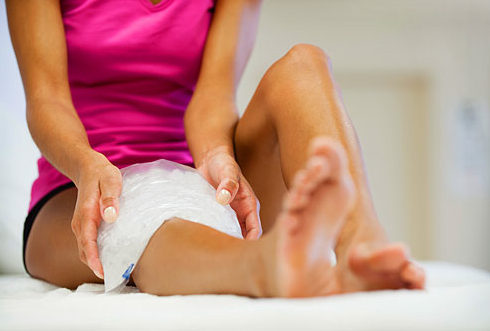Should you use ice on your injuries?
by Sally Harrison, Perfect Form Physiotherapy
Ice has always been the number one go to when we have an acute injury, but is it the best option?
We are all familiar with the concept of R.I.C.E. – being Rest, Ice, Compression and Elevation. This is then normally followed by M – movement.
However, new research by Jennifer Denys and Rebecca Dietzel has seen the creation of a new protocol that offers a slightly different strategy for dealing with an injury.
B.E. C.A.L.M. protocol!
The thinking behind this new approach is that ice can be seen to be more harmful than helpful!
Inflammation following an injury is actually a very positive response. It brings to the site of injury all the cells required for healing and removal of potential infection. These white blood cells and clotting factors are delivered via permeable blood vessels. The blood vessels become ‘leaky’ in response to chemicals released to allow the healing cells to get to the site of injury.
This increase in fluid is seen with swelling in the area. We also feel heat in the skin from increased cellular activity.
If we apply ice we can restrict the permeability of the vessels and, therefore, reduce the amount of macrophages (white cells) and clotting factors to the site of injury. Ice can also slow the response of the lymph system which acts as the waste bin and removes end products from the injury site.
So can we still use ice?
Absolutely! Ice has a great effect on pain management and in the reduction of bleeding.
With an acute injury we perceive pain which derives from the chemicals released in the area and also from the increase in pressure from the extra fluid. Ice has been shown to have a positive effect on affecting these nociceptive signals to the brain and perception of pain.
We also want to remember that we don’t want excessive bleeding at the site of injury, so if there has been significant tissue trauma we still want to stem the flow with the vasoconstriction caused by the application of ice. Compression also has a big role to play here and should be applied early on in a distal to proximal manner (external to internal).
So what is the B.E. C.A.L.M. protocol?
The following protocol is taken from Denys & Dietzel’s website detailing their recommended injury mangament programme. They outline 2 versions: soft tissue and suspected bone injuries.
BE CALM for Soft Tissue Injuries
B = BREATHE
Calm, deep breathing is the most powerful way to calm yourself and your nervous system. With each breath, move your lower ribs slowly in and out. Aim for a slow and long inhale and exhale with each breath cycle. Let your mind focus on the air moving in an out, not on the 1001 possible worries that will only rev up your already alarmed nervous system.
E = EVALUATE
Once you’re calm, you want to sort out if you’re dealing with a soft tissue or a bone injury. This stage is very important, as there are certain things you just shouldn’t do if it’s a bone injury. Whenever possible, seek the help of a qualified person like a physio, teacher, or trainer for this stage. If you’re on your own or helping a friend, here are some things to look for that suggest the need for immediate medical attention:
- Are you unwilling to move the body part? If so, suspect a fracture and proceed with BE CALM for Bones.
- Are you unable to bear weight? (This is more than just pain with weight-bearing, but a serious unwillingness/inability to bear weight.) If so, suspect a fracture and proceed with BE CALM for Bones.
- Is the pain coming from a sharply painful, very specific spot on a bone (in other words, can you point to the pain with one finger)? If so, suspect a fracture and proceed with BE CALM for Bones.
- Have you suffered any loss of consciousness, even momentary, or are you bleeding? If either is the case, or if you suspect a head or spinal cord injury, seek emergency medical care.
If your answer to all the above is ‘NO’, you can continue with BE CALM for Soft Tissues:
C = COMPRESSION
You would not compress a fracture which is why ‘E = Evaluate’ is so important. For compression, use an elastic tensor bandage and gently wrap the affected area. If your compression crosses a joint (as with a sprain), place the joint as close to the joint’s neutral position as possible. This neutral position is to help send as many normal signals from the affected body part to the nervous system as possible. It is also important not to block your circulation by making tight circles with the elastic bandage. Choose diagonals like a figure 8 instead.
A = ABLE ACTIONS
Slowly and carefully move your injured body part to ascertain which movement(s) you can do in a pain-free manner. These are your ‘able actions.’ Practice your able actions slowly for one minute every hour. Pain-free is the key here. Don’t worry if the pain-free range is a very small one. The important thing is to slowly and carefully move in ways that do not hurt.
As for walking, if you can walk with minimal pain and without a limp, you may walk calmly and carefully. Otherwise, use supports like crutches or a cane to achieve pain-free mobility.
L = ELEVATION
You can use gravity to help your body naturally limit swelling by simply elevating the injured body part above the level of your heart. The best way to do this is to lie down on your back and raise the affected area by resting it on a chair, a stack of pillows, or even on a pile of clothes. Anything you have close by that is soft will do.
M = MINIMAL ICE
If the pain is so intense that you are finding it hard to ‘BE CALM’, go back to the B in BE CALM and BREATHE. Deep slow breathing with a focus on a long exhale can decrease pain. If you feel like you need to do something more to help with pain, use the ‘minimal ice’ rule to naturally help calm the pain. This is:
- 5 minutes maximum for ice ON, 20 minutes ice OFF, 5 minutes maximum ice ON
Remember that this is a strategy for responding to an injury. It is NOT a full treatment plan. Prioritise seeing a physiotherapist after 48 hours (or within 48 hours if injury is severe) for further treatment.
The extras for suspected bone injury include:
C = CRUTCHES
Crutches will help you avoid putting weight on an injured hip, knee, ankle or foot. Aside from keeping weight off your lower limb, you also need to immobilise the affected part until you can see a doctor. The most important thing is to stop moving the part. A splint is very helpful in this regard. For upper body injuries, a sling is also a good strategy for immobilising the injured body part.
A = ARRANGE X-ray
You will need to get an X-ray as soon as possible. You can either go to the emergency room or see your doctor as soon as possible. Getting an image of the fracture is the best way to determine how to proceed with treatment.
In summary:
- Stop, breathe and remain calm. Ensure there is no danger nearby.
- Assess what has happened. Is there immediate bruising? (bleeding), immediate swelling? (larger tissue damage) Does it seem/look like a fracture?
- Add compression with an elastic bandage. Ensure it’s not too tight and the circulation is good in the extremities.
- What can you do? Can you move it? Can you walk?
- Elevate above or level to the heart
- Ice if pain is too much or there is significant bleeding.
- Seek medical help (GP, physio, emergency if very severe)
After a soft tissue injury it is essential that you keep the area moving. As the tissue heals it needs guidance to heal along normal lines of stress. Be guided by pain. It doesn’t have to be pain free, but there should be no major increase in symptoms.
It is always useful to see a dance physio to ensure that there are no latent issues from this injury that could lead to something else down the track. Even a small ankle sprain can lead to pelvic, hip and ankle issues later on if not dealt with 100% at the time of injury.
Injuries do happen even when we are very careful, so take care.









